In recent years, the concept of smart homes has gained significant traction, blending advanced technology with cutting-edge design to create spaces that are not only aesthetically pleasing but also highly functional. As we look toward the future, the integration of innovative systems into home design is set to revolutionize the way we live, work, and interact with our environments. Here’s how the intersection of technology and design is shaping the smart homes of tomorrow.
The Core Elements of Smart Homes
At the heart of a smart home is the seamless integration of devices and systems designed to enhance the quality of life. This includes everything from automated lighting and climate control to advanced security systems, entertainment hubs, and energy management tools. A well-designed smart home incorporates these elements without compromising on aesthetics, allowing for a sleek, minimalist look that emphasizes comfort and usability.
Smart homes rely on Internet of Things (IoT) technology to connect various devices, enabling homeowners to control their environment with a touch of a button or voice command. Whether it’s adjusting the thermostat, managing energy consumption, or even feeding your pets remotely, the future of smart homes lies in creating intuitive systems that adapt to the needs of the residents.
The Role of Sustainable Design in Smart Homes
One of the most important aspects of modern smart homes is sustainability. As environmental concerns become more pressing, designers are increasingly focusing on energy-efficient solutions. This includes integrating renewable energy sources like solar panels, using sustainable building materials, and designing homes that minimize energy consumption through smart technology
MatSmall.
For example, automated lighting systems can be programmed to adjust based on natural light levels, reducing the need for artificial lighting during the day. Similarly, smart thermostats can optimize heating and cooling systems, ensuring that energy is used efficiently. These features not only reduce the home’s environmental footprint but also lower utility costs for homeowners.
User-Centric Design: Personalization at Its Best
Future smart homes will also be defined by their ability to offer personalized experiences. Home automation systems will use data from various sources, such as motion sensors and user preferences, to tailor the living environment to each individual’s needs. For example, a smart home might adjust lighting and temperature based on the time of day, the occupant’s mood, or even their health metrics MatSmall
Interior designers working on smart homes are also focusing on creating spaces that are adaptable. With the help of technology, rooms can transform in function and style at the touch of a button. A living room, for instance, could seamlessly switch from a cozy family space to an entertainment hub, complete with retractable screens and surround sound systems.
The Intersection of Aesthetics and Functionality
The challenge for designers is to integrate advanced technology into homes without compromising on visual appeal. Future smart homes will focus on blending technology into the overall design in a way that enhances, rather than detracts from, the aesthetic experience. This includes designing smart furniture that can transform based on user needs or incorporating invisible wiring systems that keep devices connected while maintaining a clean, uncluttered look.
Architects and designers are also experimenting with materials that can respond to environmental changes. For example, windows that automatically adjust their tint to control light and heat will become more common, combining practical benefits with sleek, modern aesthetics.
Security and Privacy Concerns
As homes become smarter, concerns about security and privacy are inevitable. Advanced security systems will play a critical role in smart homes, with features like facial recognition, remote monitoring, and automated locks. These systems will need to balance high-level protection with ease of use, ensuring that homeowners feel secure without being overwhelmed by complex technology.
On the privacy front, smart homes will need to address data security, ensuring that the vast amount of information collected by home devices is protected from unauthorized access.
The Future of Smart Homes: Connectivity and AI
Looking ahead, the role of artificial intelligence (AI) in smart homes is set to expand. AI-powered systems will not only learn from homeowners’ habits and preferences but will also anticipate needs before they arise. Imagine a home that prepares your morning coffee as soon as you wake up or adjusts the lighting as the sun sets—all without you having to lift a finger.
5G technology will further enhance the capabilities of smart homes, providing faster and more reliable connectivity that allows for real-time control of home devices from anywhere in the world. As this technology continues to evolve, we can expect even greater integration between home systems, creating environments that are truly responsive to their inhabitants.
Conclusion: The Home of the Future
The intersection of technology and design in smart homes offers limitless possibilities. By blending cutting-edge innovation with sustainable, user-centric design, future homes will be more than just places to live—they will be environments that adapt to our lifestyles, enhance our well-being, and contribute to a more sustainable world. As these trends continue to develop, the homes of tomorrow will redefine the way we think about our living spaces, pushing the boundaries of comfort, convenience, and creativity.
For more insights into how smart home technology is influencing interior design, visit Matsmall


